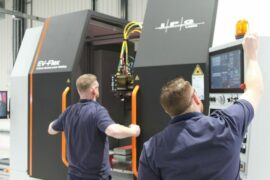Yes, you read that right – meat. As many of you will have seen in the supermarkets, there has been a significant increase in non-animal-based products available. From dairy free milk to plant-based burgers, the vegan community is rising rapidly. There are many reasons why people choose a plant-based lifestyle. From saving the lives of animals to health benefits, there are around 600,000 vegans in the UK – according to Vegan Society. With the latest electronics becoming more advanced every single day, so is the technology able to create the high demand for plant-based meat. Plant based meat is usually made up of extracted plant protein or tofu which looks and tastes like real meat. Many people prefer plant-based meat as it is lower in cholesterol and obtains more fibre. However, there have been talks of lab grown meat which is created by tissue manipulation and does not involve slaughtering animals. Would you try it?
History of artificial meat
The first burger designed with cow stem cells was made by Mark Post, a Dutch scientist from Maastricht University. Mark presented the burger to potential customers in 2013, with hope they would enjoy his creation. The downfall of the burger was the production costs were sky high which limited profit margins. Despite many setbacks such as financial costs and production times, several start-ups have since taken to the niche market.
How does it work?
Synthetic meat (lab grown meat) is created by a process which resembles the way cotton candy is spun. The manufacturer will spin the gelatine-containing solution to make tiny fibres and will add ethanol which will cause the fibres to dry out. Then the manufacturer will add stem cells which will develop into a muscle cell (replicating meat). The cells will become either cow or rabbit muscle which will grow into edible gelatin scaffold. According to Science News for Students, there was an experiment conducted by Luke MacQueen at Harvard University. The lab-grown samples all looked like the natural meats, MacQueen says. And they had similar materials properties too. Those traits affect how chewy, springy or soft the tissue is. By controlling how the gelatin fibres had been spun, the scientists could set the fibres’ alignment and spacing. That determined if the tissue ended up more like a burger or a steak.
Where do electronics come into this?
Electronics play a huge part in manufacturing artificial meat. First, sensors would be present in the manufacturing process to ensure the ‘meat’ is stable at the correct temperature. According to Science Focus, to grow cells industrially requires a large ‘bioreactor’ – a high-tech vat that can provide the perfect conditions for growth but also the movement and stimulation to exercise the cells. The largest existing bioreactor capable of doing this has a volume of 25,000 litres (about one-hundredth the size of an Olympic swimming pool), which Post estimates could produce enough meat to feed 10,000 people. It’s likely that many more of these would be needed to make a viable meat-processing plant.
Not only this, the latest technology such as 3D printers can also be used to produce artificial meat. According to Phys, tests were carried out in September to produce beef, rabbit and fish tissue using a 3D printer.
Will it be more expensive than regular meat?
Companies like Memphis Meats, Aleph Farms, Higher Steaks, Mosa Meat and Meatable are all trying to bring to supermarkets around the world meat made from cultivated animal cells, but the problem has always been the cost. According to Tech Crunch, Future Meat Technologies has raised $14 million in new financing to build its first pilot manufacturing facilities to bring the cost of production of a cell-made steak down to $10 per pound — or $4 if the meat is combined with plant-based meat substitutes. The $10 price tag is a whole lot lower than the $50 target that experts from the Good Food Institute were talking about back in April of this year — and represents a significant cost reduction that makes lab-grown meat a potentially commercially viable option much sooner than anyone expected.
What do you think of artificial meat?
Josh Hilton, Graphic Designer at eBOM – Vegan: ‘Being vegan, I feel eating artificial meat would be against my morals as I don’t agree with slaughtering animals for their meat. However, I think artificial meat is potentially better for the environment and less animals are affected.’
Thomas Smart, Editorial Manager at MMG Publishing – Meat Eater: ‘I think artificial meat is a great alternative to standard meat as it means less greenhouse gases will be produced, and it is healthier to consume.’
Would you feel comfortable consuming meat which has been grown in artificial conditions by electronics?
Josh Hilton, Graphic Designer at eBOM – Vegan: ‘I would stick to my plant-based diet as I wouldn’t feel comfortable eating artificial meat as it goes against my morals and eating habits. Even though no animals are affected, I would feel guilty eating it!’
Thomas Smart, Editorial Manager at MMG Publishing – Meat Eater: ‘I would probably try lab grown meat just to see what it’s like, but I wouldn’t necessarily choose it over regular meat unless it was the same price. It would feel strange eating something which is purely produced by electronics but rather than natural conditions – but I would be open to trying it!’
Would you consider consuming artificial meat over animal-based meat?
Josh Hilton, Graphic Designer at eBOM – Vegan: ‘I don’t eat meat – so yes.’
Thomas Smart, Editorial Manager at MMG Publishing – Meat Eater: ‘If it was within a similar price range and tasted nice then I would be open to prioritising lab meat than animal-based meat.’
By Amy Leary, Marketing Manager at eBOM.com










